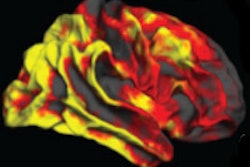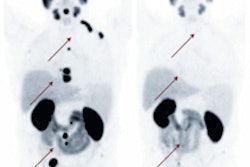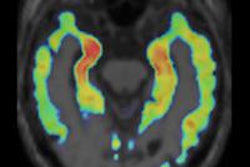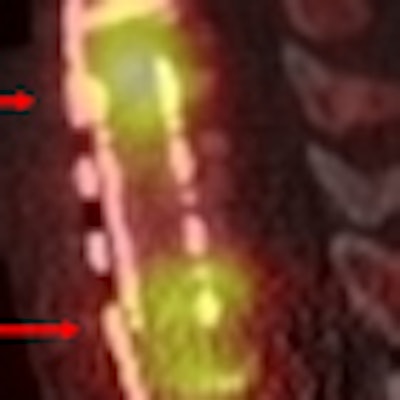
SAN ANTONIO - By capturing how PET/CT can identify abnormal bone reaction in patients who have received spinal fixation hardware implants, researchers at Stanford University received the Image of the Year award on Monday at the Society of Nuclear Medicine (SNM) annual meeting.
The image, selected from more than 1,800 studies presented at this week's meeting, demonstrates the clinical utility of PET/CT using a newly approved PET F-18 sodium fluoride (NaF) bone imaging agent to correctly pinpoint the cause of recurrent pain after surgical placement of spinal fixation hardware.
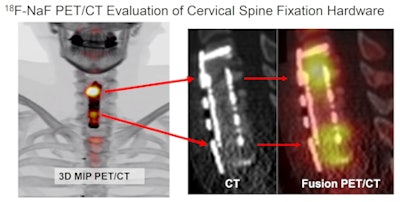 |
| The combination of the CT image (center), PET/CT image (right), and increased uptake of the NaF bone imaging agent shows the source of the back pain. Image courtesy of SNM. |
Lead study author Dr. Andrew Quon, assistant professor of radiology and chief of clinical PET/CT for the molecular imaging program at Stanford, said the NaF PET/CT image shows the potential of molecular imaging for helping patients with a very common orthopedic problem. The imaging technique, he added, is currently available to all patients.
The prospective study was conducted at the Hospital Mãe de Deus in Porto Allegre, Brazil, with patients and the PET/CT system coming from the hospital's spinal surgery department.
The study evaluated 20 patients presenting with spinal pain with PET/CT and F-18 NaF at least eight months after surgery. A total of 24 bone or tissue abnormalities were found in 17 (85%) of the 20 subjects.
Of the 20 patients, 12 received exploratory surgery and four received local anesthetic nerve blockade, a minimally invasive treatment that numbs the affected nerve for short-term pain management as an alternative to surgery.
Quon and colleagues found that F-18 NaF PET/CT was highly effective for evaluating pain after spinal surgery, and the imaging technique was able to identify the exact source of pain in 85% of the patients.
By identifying the source of the back pain, physicians can then direct the appropriate treatment toward corrective surgery or the therapeutic nerve blockade, the authors noted.





